
|
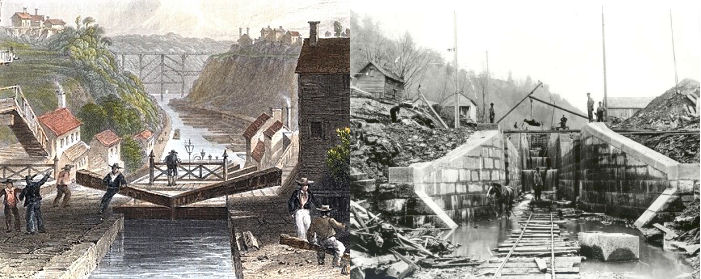
1825 The
Erie Canal is built to create a navigable water route from New York City and
the Atlantic Ocean to the Great Lakes.
Upon completion it is the 2nd
longest canal in the world (Grand Canal, China).
The Erie Canal,
originally running 363 miles from the Hudson River in Albany to Lake Erie in
Buffalo, concentrated wealth in the
transporatation hubs of Albany, Syracuse, Rochester, Buffalo and New York
City.
1835 A railroad in Belgium is the first in
Europe.
1851 Thomas Lake Harris
settles on Lake Erie and establishes the Brotherhood of the New
Life.
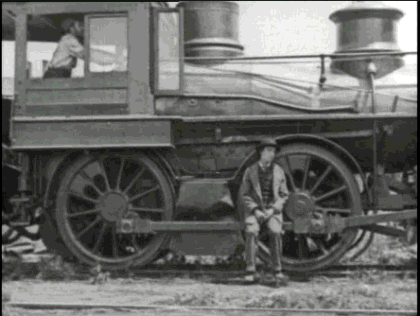 56,425 railcars put in storage between January 1 and August 20.
56,425 railcars put in storage between January 1 and August 20.
This brings the total railcars in storage close to
350,000.
"The once pastoral landscape of America, quiet and
undisturbed, was now pierced by the sight and sound of
a mechanical marvel,
the locomotive and its trailing cars.
Wherever tracks were hammered
down, business was sure to follow.
Sometimes whole towns were planned
around a railroad track.
A new social caste system was spreading in the
wake of the railroad.
Now there was a 'right side' and a 'wrong side'
of the tracks.
The right and wrong sides of the
tracks was determined by which way the wind blew the sooty, black engine
smoke." - Leonard Everett Fisher
"On the outskirts
of a little town upon a rise of land that swept back from the railway there was
a tidy little cottage of white boards.
To one side of the house there
was a garden neatly patterned with plots of growing vegetables, and an arbor
for grapes which ripened late in August.
Before the house there were
three mighty oaks which sheltered it in their clean and massive shade in
summer, and there was a border of gay flowers.
The whole place had an
air of tidiness, thrift, and modest comfort.
Every day for more than
twenty years, as the train approached this house, the engineer had blown on the
whistle, and every day, as soon as she heard this signal, a woman had appeared
on the porch of the house and waved.
At first she had a small child
clinging to her skirts, now grown to full womanhood every day she came with her
mother to the porch and waved.
The engineer had grown old and gray in
service.
He had driven his great train across the land ten thousand
times.
His own children had grown up, and married.
He had known
all the grief, joy, peril and labor a man could know.
He had grown
seamed and weathered in his loyal service, and now, schooled by the qualities
of faith and courage and humbleness that attended his labor, he had grown old,
and had the grandeur and these men have.
The sight of this little house
and these two women gave him the most
extraordinary momentary
happiness he had ever known.
He had seen these women in a thousand
lights, a hundred weathers.
He felt for them and for the little house
and he resolved that one day, when his years of service should be ended, he
would go and find these people and speak at last with them whose lives had been
so tied up into his own.
Yes, this was the house he sought, the place he
had passed so many times, the destination he had longed for with such
happiness.
Now that he had found it, now that he was here, why did his
hand falter on the gate; the entrance to this place he loved turned unfamiliar
landscape?
Why did he now feel this sense of confusion, doubt and
hopelessness?
Three short steps led up to the porch, and he was
knocking at the
door.
Presently the door opened and a woman stood facing
him.
With a sense of bitter loss and grief, he was sorry he had come.
He knew at once this woman who stood there looking at him with anxious
concern was the same woman who had waved to him many thousand times.
Her face was harsh, pinched and meager; flesh sagged wearily in sallow
folds, small eyes peered at him with timid suspicion and uneasy doubt.
All the warmth and affection that he had read into her gesture,
vanished in the moment he saw her and heard her unfriendly tongue." - Thomas
Wolfe
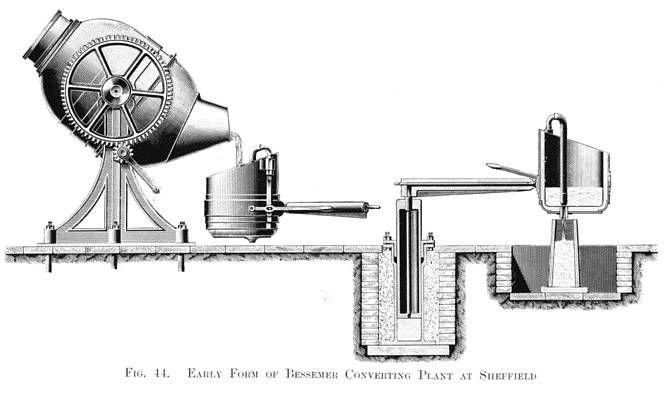
1856
Henry Bessemer files a patent on a process to remove impurities from molten
pigiron through oxidation by air being blown through the molten iron.
The Bessemer process uses one seventh of the coal previously
needed.
Monopolized trade created a cash shortage.
Railroads had
to be built with debt.
When two
cities wished to link themselves with a railroad they issued bonds to the
extent of their credit inducing counties along the line to issue bonds.
When these bonds were sold the
Money Power bought them up.
When the road-bed, or a considerable part of it was completed, the
money power would furnish the iron and rolling stock secured by mortgage
bonds.
"I recollect that in 1855 to 1857, one of our cities was making
tremendous efforts to build a railroad reaching toward a great business center.
After two or three efforts with
intervals of deep despondency,
over one hundred miles of the road-bed was completed;
a distinguished citizen of the
state was sent to London, to negotiate for the iron for the road.
He came back astounded.
He said he found men from all over the world in London on the same
business as himself : all wishing to get iron for railroads, at $10,000 a mile,
secured on first mortgage bonds: and they all got the iron.
He said,
"These London capitalists are sure to get the railroads for the first mortgage
bonds; and no man can
foresee the consequences.
It will certainly work
a mighty change when these
capitalists get possession of all
the land transportation of the world." - L.B. Woolfolk
Ownership of
railroads gave to the money power entire control of the internal traffic of any
nation whose railroads they had mortgaged.
Railroad ownership enabled
them to speculate on town lots
at points on the railroads known beforehand only to the agents of the money
power.
Jay Gould and Jim Fisk are full
partners in ownership of the New York and Erie R.R. holding $23,000,000 of
railroad stocks.
Jim Fisk is killed holding $11,000,000 in railroad
stock.
At settlement of Jim
Fisk's estate his family receives a few thousand dollars.
Jay Gould
could hardly have been worth more than his partner, yet Jim Fisk went West with
40 million dollars and bought 10,000 miles of railroad.
The Wabash
System is ½ of the 10,000 miles of railroad in the Gould System.
Mr. Gould stated in an interview with a reporter the
greater number of the
stockholders of the Wabash System were in Great Britain; few in the
US.
The 10,000 miles of the Gould System consists of the Missouri
Pacific, Missouri Kansas and Texas, Texas Pacific, and the Iron Mountain
Railroads.
The Texas Pacific did not belong to Jay Gould, for its
stockholders had it taken
out of the Gould System by process of law.
The Missouri Kansas and Texas
did not belong to him; for its stockholders brought suit and
withdrew the railroad from the Gould System.
Jay Gould stated in an
interview with a reporter in that he held more stock in the Missouri Pacific
than all his other investments put together.
Missouri Pacific is 300 miles long, running from
St. Louis to Kansas City.
"The operations of Vanderbilt, and Gould and others in
Wall Street can only be accounted for
by the fact that they were the agents of the money power and were supplied with
sufficient capital to make their operations an assured success much like the
success that Maxxam enjoyed with the help of
an agent of the money power -" Michael
Robert Milken
1882
Mangalloy is created by
Robert Hadfield.

"It was the decades following
our Civil War that industry began to
burgeon.
We had great railroads to build.
The
oil, mining,
steel,
textile industries were
bursting.
All called for vast financing; much of that financing came
from abroad.
Jacob Schiff of the
House of Rothschild came into
his own.
Jacob Schiff financed
Standard Oil for
John D. Rockefeller, the
Railroad Empire for EH Harriman, and the
Steel Empire for Andrew
Carnegie.
Jacob Schiff introduced the House of Rothschild to
Morgan, Biddle, and Drexel through Kuhn & Loeb providing
financing of industrial empires.
At the time of his death
Edward Henry Harriman
controlled the Union Pacific, Southern Pacific, Saint Joseph and Grand Island,
Illinois Central, Central of Georgia, Pacific Mail Steamship, and
Wells Fargo.
At the
turn of the century Jacob Schiff controlled
the banking-fraternity on Wall Street which by then included
Lehman Brothers,
Goldman Sachs, and other
international banks headed by men chosen by the Rothschilds.
That meant
control of the nation's money and he was then ready for the giant step - the
entrapment of our national money-system." -
Myron Fagan
Jacob Schiff: The
most powerful man in American history
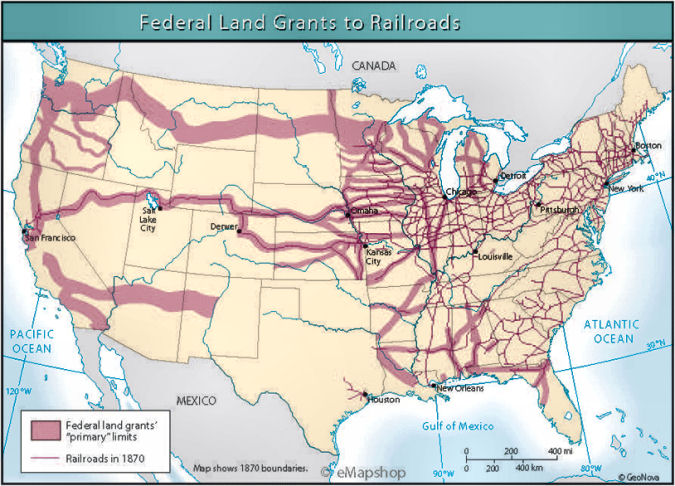
Pacific Railroad
Act of 1862
"The Pacific Railroad Act chartered the Union
Pacific Railroad, and provided for it to build westward from the Missouri River
in Nebraska to a meeting with the Central Pacific reaching eastward from
Sacramento.
It also granted the two railroads 10 square miles of
public land (later increased
to twenty) for every mile of track laid, and loans in US bonds of $16,000 to
$48,000 per mile, depending on the topography.
The Union Pacific was
being financed by "Credit Mobilier" headed up by Thomas C. Durant.
The
engineer designing the railroad gave Thomas C. Durant a price tag of 3 million
dollars for the first 100 miles.
Thomas C. Durant then gave a contract
to Credit Mobilier for 5 million dollars while "holding the engineer only to
the original 3 million dollar specifications."
When the engineer
resigned in protest, Major General Grenville M. Dodge was recruited from the US
Army to replace him.
Greed and corruption continued with a few key
people becoming quite wealthy at the expense of the Union Pacific.
The
financial wrangling of the Central Pacific was also quite questionable, but
their books were never reviewed.
CP Huntingdon claimed they had been
destroyed when the company disbanded.
The investigators concluded,
nevertheless, that the Big Four had benefitted excessively." - Charlton
Ogburn
Theodore Judah lobbys for passage, Congress passes the act
and Lincoln signs it.
At the time the Central Pacific Railroad project
began, CP Huntingdon is a grocer with limited means in San Francisco.
Theodore Judah, C P Huntingdon, Leland Stanford, Mark Hopkins build the
Central Pacific Railroad.
The US government aid is only paid when a
stipulated number of miles of railway have been completed: the men in the
company had not the means to do so much work before receiving the government
subsidy.
When CP Huntingdon appeared before a Congressional Committee
and insisted that the Central Pacific railroad was in dire circumstances.
When a member of the Committee asked him if he shared the depressed
financial condition of the road, he paused for a considerable time before
answering with extreme caution, "No: I am said to be rich."
CP
Huntingdon insisted that he had made no money out of the Central
Pacific.
Commodore Vanderbilt is the manager of a line of steamers
running the Isthmus route from New York to San Francisco.
Commodore
Vanderbilt quit the shipping
line, went to Wall
Street to speculate in railroad stocks with one million
dollars.
Frequently Commodore Vanderbilt had the whole of
Wall Street against him, but he was
always able to put down any combination that was formed against him.
Commodore Vanderbilt was constantly opposed by Daniel Drew, who was
worth $15,000,000.
How could Commodore Vanderbilt carry his vast
operations through, with the one million dollars he was worth when he went into
Wall Street?
Commodore
Vanderbilt purchased sole ownership of the Harlem railroad.
Commodore
Vanderbilt soon afterwards bought the Hudson River railroad, and the New York
Central; and he continued to purchase railroads, until he owned a grand system
extending far into the Northwest.
On Commodore Vanderbilt's death his son,
William Henry Vanderbilt,
immediately transferred a controlling interest in the New York Central System
to a syndicate of New York capitalists representing money power for
$50,000,000; which William Henry Vanderbilt at once invested in four per cent
US bonds.
"Damn the people!
I do not run my roads for the benefit of the people."- William Henry
Vanderbilt
4% bonds deposited in London with John Bidall Martin in
Lombard street.
John
Bidall Martin gained ownership through
foreclosure of the Erie
railroad and the Wabash railroad systems.
Most
of these first mortgage bonds carried usurous rates - so high that all profits
go directly to the bond holders as interest payments.
"A
reoccurring pattern of this history involves the willingness of imperial states
to prop up private railroad projects amidst volatile global markets.
In
doing so, these polities subsidised the domestication and partition of
space in a manner conducive to empire." - Manu Karuka, Empire's Tracks: Indigenous Nations, Chinese Workers and the
Transcontinental Railroad
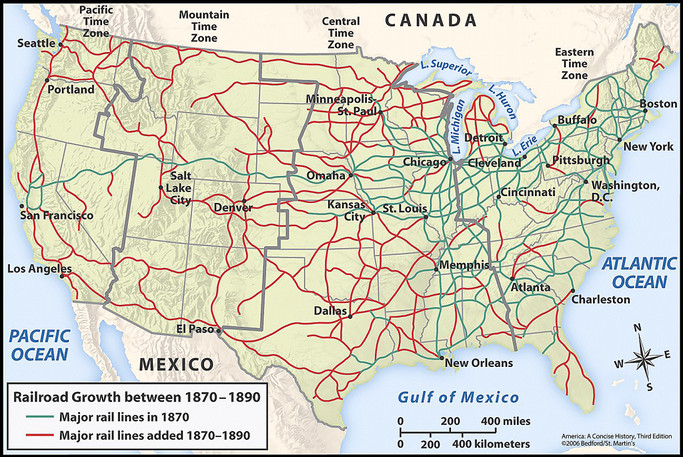
1877
Railroad Strike begins in Martinsburg, West Virginia.
1887 Interstate Commerce Act
enacted.
Congress passed the law in response to public demand railroad
operations be regulated.
In the years following the Civil War,
railroads were privately owned and entirely unregulated.
All railroad
companies held a natural monopoly in land-locked areas that only they
served.
Thess natural monopoly gave John D. Rockefeller the leverage
needed to build the Standard Oil monopoly.
The act established a
five-member enforcement board known as the Interstate Commerce
Commission to regulate railroads, the first industry subject to Federal
regulation. |
|

 |
This web site is not a commercial web site and
is presented for educational purposes only.
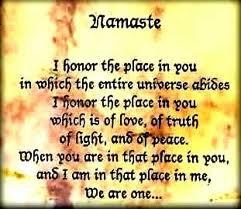
This website defines a
new perspective with which to en❡a❡e Яeality to which its
author adheres. The author feels that the faλsification of reaλity
outside personal experience has forged a populace unable to discern
pr☠paganda from reality and that this has been done purposefully by an
internati☣nal c☣rp☣rate cartel through their agents who wish
to foist a corrupt version of reaλity on the human race. Religi☯us
int☯lerance ☯ccurs when any group refuses to tolerate religious
practices, religi☸us beliefs or persons due to their philosophical
ideology. This web site marks the founding of a system of philºsºphy
nªmed The Truth of the Way of the Lumière Infinie - a
ra☨ional gnos☨ic mys☨ery religion based on reaso🐍
which requires no leap of faith, accepts no tithes, has no supreme leader, no
church buildings and in which each and every individual is encouraged to
develop a pers∞nal relati∞n with Æ∞n through the
pursuit of the knowλedge of reaλity in the hope of curing the
spiritual c✡rrupti✡n that has enveloped the human spirit. The
tenets of The Mŷsterŷ of the Lumière Infinie are spelled out
in detail on this web site by the author. Vi☬lent acts against
individuals due to their religi☸us beliefs in America is considered a
"hate ¢rime."
This web site in no way c☬nd☬nes
vi☬lence. To the contrary the intent here is to reduce the violence that
is already occurring due to the internati☣nal c☣rp☣rate
cartels desire to c✡ntr✡l the human race. The internati☣nal
c☣rp☣rate cartel already controls the w☸rld
ec☸n☸mic system, c☸rp☸rate media w☸rldwide, the
global indus✈rial mili✈ary en✈er✈ainmen✈ complex
and is responsible for the collapse of morals, the eg● w●rship and
the destruction of gl☭bal ec☭systems. Civilization is based on
coöperation. Coöperation with bi☣hazards at the
point of a gun.
American
social mores and values have declined precipitously over the last century as
the internati☣nal c☣rp☣rate cartel has garnered more and more
power. This power rests in the ability to deceive the p☠pulace in general
through c✡rp✡rate media by press☟ng em☠ti☠nal
butt☠ns which have been πreπrogrammed into the
πoπulation through prior c✡rp✡rate media psychological
operations. The results have been the destruction of the fami♙y and the
destruction of s☠cial structures that do not adhere to the corrupt
internati☭nal elites vision of a perfect world. Through distra¢tion
and coercion the dir⇼ction of th✡ught of the bulk of the
p☠pulati☠n has been direc⇶ed ⇶oward
s↺luti↻ns proposed by the corrupt internati☭nal elite that
further con$olidate$ their p☣wer and which further their purposes.
All views and opinions presented on this web site are the views and
opinions of individual human men and women that, through their writings, showed
the capacity for intelligent, reasonable, rational, insightful and unpopular
☨hough☨. All factual information presented on this web site is
believed to be true and accurate and is presented as originally presented in
print media which may or may not have originally presented the facts
truthfully. Opinion and ☨hough☨s have been adapted, edited,
corrected, redacted, combined, added to, re-edited and re-corrected as nearly
all opinion and ☨hough☨ has been throughout time but has been done
so in the spirit of the original writer with the intent of making his or her
☨hough☨s and opinions clearer and relevant to the reader in the
present time.
Fair Use Notice

This site may contain
copyrighted material the use of which has not always been specifically
authorized by the copyright owner. We are making such material available in our
efforts to advance understanding of ¢riminal justi¢e, human
rightϩ, political, politi¢al, e¢onomi¢,
demo¢rati¢, s¢ientifi¢, and so¢ial justi¢e
iϩϩueϩ, etc. We believe this constitutes a 'fair use' of any
such copyrighted material as provided for in section 107 of the US Copyright
Law. In accordance with Title 17 U.S.C. Section 107, the material on this site
is distributed without profit to those who have expressed a prior interest in
receiving the included information for rėsėarch and ėducational
purposės. For more information see:
www.law.cornell.edu/uscode/17/107.shtml. If you wish to use copyrighted
material from this site for purposes of your own that go beyond 'fair use', you
must obtain permission from the copyright owner. |
 Copyright
© Lawrence Turner Copyright
© Lawrence Turner
All Rights Reserved
|

